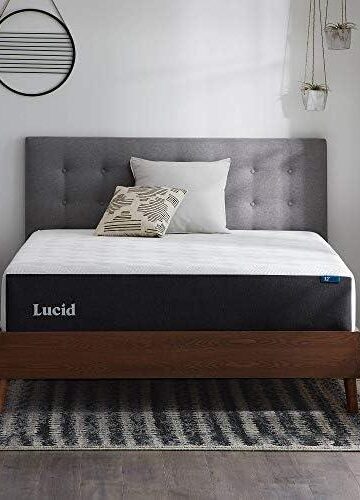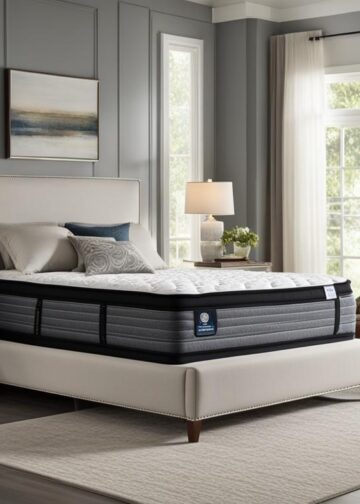Both Queen and Full sizes are highly favored in terms of use. They share a lot of resemblances. Although visually similar, the main distinction lies in their dimensions. In this article, we will elaborately discuss both the Queen and Full sizes.
![]()
We anticipate that by the conclusion of this article, the dimensions and additional differences between the Queen and Full sizes will be evident. We’ll examine each one progressively:
Exploring the Queen Size
The Queen size bed has increasingly become the top choice for many individuals. It began to gain popularity in the 1950s, with several advancements shaping it into the modern Queen size we know today. This bed measures 60 inches in width and 80 inches in length, or 153 by 203 centimeters, offering each individual approximately 27 inches or 68.8 centimeters of width. The total surface area for a Queen size bed is 4,800 square inches. A bedroom that is at least 9 feet wide by 11 feet long is required to accommodate a Queen size bed.
Queen size beds fit perfectly in medium-sized bedrooms and guestrooms. They are ideal for couples or individuals who share their bed with pets or children. The length of the Queen bed suits the majority of people, and due to its popularity, it is readily available. Comparatively, its accessories are more affordable than those for King and California King sizes. The typical cost of a Queen bed ranges from $800 to $1,200.
Read also: Best Queen Mattress Under $500.
Here are some advantages and disadvantages of the Queen size:
Advantages of Queen Size:
- Ample space: Provides sufficient space for single sleepers, and also accommodates couples comfortably. The dimensions are well-suited for nearly all bedrooms.
- Easily accessible: Due to its widespread use, Queen size beds are accessible in any part of the world. All major brands manufacture this size, ensuring its availability.
- Accommodates taller individuals: With an 80-inch length, even taller individuals can sleep without their feet hanging off the edge.
Disadvantages of Queen Size:
- Price: The Queen size bed comes with a higher price tag, making it less affordable for many people on a budget. A high-quality Queen mattress may cost up to $1500, which is about $100 to $400 more than the Twin, Twin XL, and Full sizes.
- Requires more space: It demands a space at least 9 feet by 11 feet, making it unsuitable for smaller rooms. Other sizes might be more suitable for limited spaces.
- Heavy: Weighing around 100 pounds, it can be challenging for one person to move alone. It often requires asking for help, which can be inconvenient.
Exploring the Full Size
Also known as the ‘Double’, the standard Full size measures 75 inches in length and 54 inches in width, or 137 cm by 190 cm. It occupies a total surface area of 4,050 square inches. Full-size beds fit ideally into rooms measuring 10 feet in length and 8.25 feet in width, offering approximately 30 inches or 76 cm of width per individual. Due to the popularity of Queen, King, and California King sizes, the Full size has seen a decline in popularity.
Full-size beds are an excellent choice for individuals living in smaller spaces. They comfortably accommodate an average-sized adult or two teenagers. This size is commonly utilized in settings requiring space-efficient solutions, like college dorms, healthcare facilities, and double-bed hotel rooms. They are generally lighter and less costly compared to Queen, King, and California King sizes, with prices ranging from $550 to $800. They are also widely available.
Here are some pros and cons of the Full size:
Advantages of Full Size:
- Requires less space: Needs less room compared to Queen, King, and California King sizes, making it suitable for more compact bedrooms.
- Affordable: Generally priced between $400 and $500, making it considerably more budget-friendly than other sizes. The affordability makes Full sizes accessible to more people.
- Additional room for single sleepers: Offers sufficient space for a single adult, providing more comfort than Twin or Twin XL sizes.
- Broadly available: Being one of the most commonly used bed sizes globally, Full-size beds and their accessories are easily found.
- Easier to move: Typically weighs less than 80 pounds, facilitating easier handling and relocation by one person.
Disadvantages of Full Size:
- Not suitable for couples: Although ideal for single use, Full-size beds do not comfortably accommodate couples. It’s not the best choice for those sharing a bed with a partner, pets, or children.
- Not ideal for large rooms: In larger bedrooms, Full-size beds can appear disproportionate due to their smaller dimensions.
- Insufficient for very tall individuals: People taller than 6 feet might find the Full size too short, leading to discomfort.
The detailed examination of the Queen and Full sizes above should offer a clear understanding of these options. We have also included a table to illustrate the size differences and other aspects:
| Differences | Queen | Full |
| Width (Inches) | 60” | 54” |
| Length (Inches) | 80” | 75” |
| Width (Centimeters) | 153 cm | 137 cm |
| Length (Centimeters) | 203 cm | 190 cm |
| Width Per Person | 30Inches/ 76Cm | 27Inches/ 68.8Cm |
| Surface Area | 4,800 Square Inches | 4,050 Square Inches |
| Ideal Bedroom Size | Minimum: 9 ft. wide x 11 ft. long | |
| Cost of Accessories | Accessories for a Queen bed are less pricey than for King size but pricier compared to Twin or Full beds. | Accessories for the Full bed are more budget-friendly than Queen size but costlier than Twin size. |
| Popularity | 32% of All Purchases | 21% of All Purchases |
| Best for | Couples and individuals sharing their bed with children or pets | Single adults with limited room space |
| General Use | Typically used in guest or smaller master bedrooms. | Optimal for compact spaces. Suitable for one adult or two teenagers. |
| Comfortably Fits | Single sleepers who prefer ample space or couples requiring moderate space. | Single sleepers of average height desiring additional sleeping room. |
| Average Price Range | $800 to $1,200 | $550 to $800 |
| Size differential | The Queen is 5 inches longer and 6 inches wider than the Full. | The Full is 5 inches shorter in length and 6 inches narrower than the Queen. |
| Summary | The Queen is a sovereign entity unto itself. | Often referred to as a double bed. In America, it retains a consistent size, while in Europe, its dimensions may vary. |
This table indicates that the Queen size is slightly larger than the Full size, with minor dimensional variations. Queen dimensions are 5 inches longer and 6 inches wider than Full dimensions.
We trust this article will aid you in understanding the differences in size between Queen and Full.
Source: AanyaLinen.com, Tuck.com
- “Sleep Like Royalty: Discover the Lucid 12″ Cal King Mattress!” - February 14, 2024
- “Is Your Mattress Past Its Prime? Find Out Now!” - February 11, 2024
- Sleep Better Every Season: Seasonal Sleep Tips - January 26, 2024









